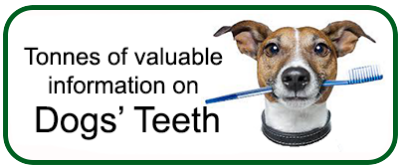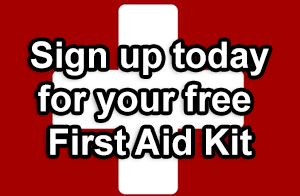Everything you need to know about general anesthesia for
Dental procedures in Dogs
Dental procedures for cleaning and or extracting dogs teeth under general anesthesia
Dog dental anesthesia - general anesthesia |
Dental cleaning and prophylactic procedures |
Polishing dogs' teeth |
Extracting dogs teeth
Alveoloplasty in dogs |
Antibiotics and their place in oral treatments for dogs
Dental pain relief for dogs |
IVF (intravenous fluids) for dogs
Dental procedures for cleaning and or extracting dogs teeth under general anesthesia
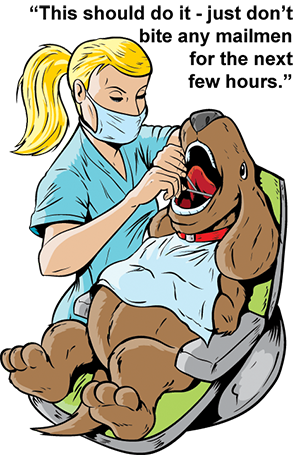
Whilst a good diet and soft raw bones such as chicken necks and beef brisket bones and are the fundamentals of good oral health for dogs, sometimes they aren't quite enough.
Some dog owners need and appreciate a helping hand to get started on the right track for optimum dental health for their pooch.
Depending on the symptoms of gum disease your dog is experiencing and the severity or Grade of the periodontal disease present, we have listed the various procedures that are involved, when your dog undergoes a general anesthetic to have its teeth cleaned or extracted.
Dog dental anesthesia - general anesthesia
Modern day dog dental anaesthesia sometimes referred to as general anaesthesia, are very safe for dogs.
Because it isn't possible to reason with our pets, general anesthesia together with the accompanying immobilisation is the only safe way vets can clean and scale and/or do extractions.
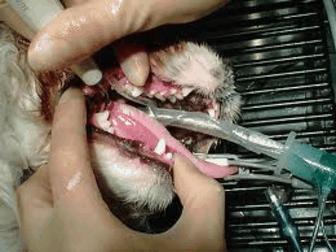
Prior to dog dental anaesthesia being administered urine and blood tests are done in order to check that dogs are well enough to proceed to theater.
This is particularly relevant in the case of older dogs and/or dogs with heart murmurs, which may require alternative or additional drugs to keep them safe.
During dog dental anesthesia a tube is placed down the dog's throat into its lungs - this is used for administering anesthetic drugs and medical oxygen throughout the entire procedure. The tube also prevents any bacteria from the mouth enter the dog's respiratory system.
Dental cleaning and prophylactic procedures
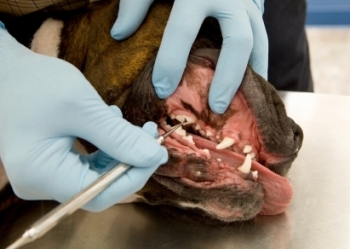
Removal of plaque and calculus from a dogs teeth is called "scaling". Scaling is done with an ultrasonic scaler, which vibrates and breaks up the calculus without causing any damage to the teeth.
Nothing is overlooked and all teeth surfaces are scaled, cleaned and polished.
After the ultrasonic scaler has done its job, hand scalers are used to complete the removal of Plaque and Calculus from below the gingival margins or gum lines. This procedure is called "root planning and subgingival curettage".
Polishing dogs' teeth
Polishing, is carried out after scaling has been completed. Polishing is necessary, because very often some teeth can still be left with rough surfaces which, if left, would encourage the formation or reattachment of plaque and calculus. To avoid this happening, vets polish dogs teeth with a polishing paste to restore a smooth healthy surface both above and below the gum lines.
Extracting dogs teeth
Extractions are required when:
- The tooth enamel is badly eroded.
- Crowns have broken, or where only roots remain.
- Teeth have abscessed.
- The supporting periodontal tissues are damaged to the point where Periodontits is present and they can no longer support a tooth or teeth.
Sometimes it is only possible to decide if a tooth can be saved, after the calculus has been removed. Other times, the decision whether to extract a tooth or try to save it can be influenced by the owner's ability or willingness to keep the dog's teeth and gums clean at home.
Where Brushing At Home is not going to happen it is better to extract a tooth or teeth to maintain the health of the rest of the mouth for as long as possible.
Once a tooth is extracted the socket is flushed with saline and then the bone crest is smoothed over with a round bur or file.
Alveoloplasty in dogs
This smoothing over process is called alveoloplasty, and is done primarily to allow vets to suture the soft gingival tissues together in such a way that there will not be any tension in the gums when the dog starts eating again.
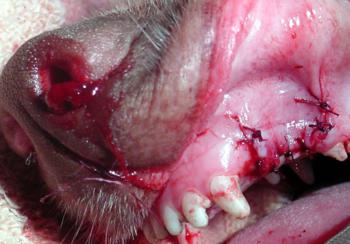
Sockets are always closed with a suture (as in this photo) to avoid any food or foreign objects getting lodged in the socket/s (the space where the teeth have come out of), and thus avoid setting off another round of infection and or the formation of dry sockets.
For the first week or so after extractions it is wise to give your pooch soft foods.
Antibiotics and their place in oral treatments for dogs
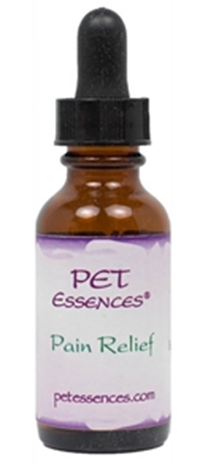
Antibiotics, are routinely prescribed:
- When Gingivitis and or Periodontitis are present.
- Before and after normal cleaning and prophylactic procedures.
- Before and after, when teeth have been extracted.
Dental pain relief for dogs
Dogs experience the same Pain and discomfort after invasive dental treatments as humans, and most vets describe pain-relievers as standard treatment depending on the severity of the procedure your dog has had done.
IVF (intravenous fluids) for dogs
IVF, intravenous fluids are pretty standard nowadays, particularly as vets recommend "nil by mouth" for at least six (6) hours prior to a dog undergoing a general anaesthesia for dental procedures.
This article and information forms part of the Carole's Doggie World Holistic Library and is presented for informational purposes only.The information is not intended to be a substitute for visits to your local vet. Instead, the content offers the reader information researched and written by Carole Curtis for www.carolesdoggieworld.com

